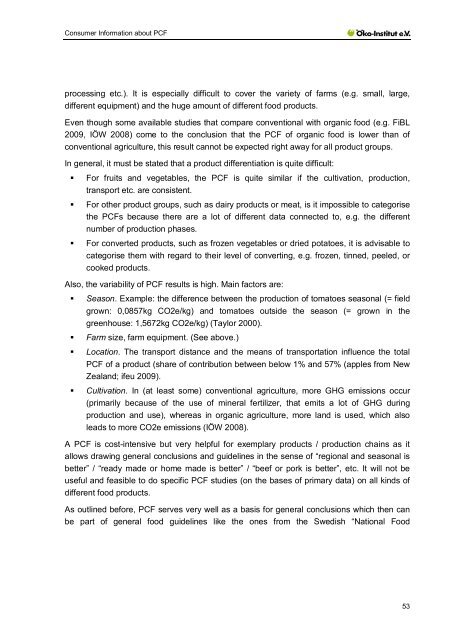Requirements on Consumer Information about Product ... - ANEC
Requirements on Consumer Information about Product ... - ANEC
Requirements on Consumer Information about Product ... - ANEC
You also want an ePaper? Increase the reach of your titles
YUMPU automatically turns print PDFs into web optimized ePapers that Google loves.
C<strong>on</strong>sumer Informati<strong>on</strong> <strong>about</strong> PCF<br />
processing etc.). It is especially difficult to cover the variety of farms (e.g. small, large,<br />
different equipment) and the huge amount of different food products.<br />
Even though some available studies that compare c<strong>on</strong>venti<strong>on</strong>al with organic food (e.g. FiBL<br />
2009, IÖW 2008) come to the c<strong>on</strong>clusi<strong>on</strong> that the PCF of organic food is lower than of<br />
c<strong>on</strong>venti<strong>on</strong>al agriculture, this result cannot be expected right away for all product groups.<br />
In general, it must be stated that a product differentiati<strong>on</strong> is quite difficult:<br />
• For fruits and vegetables, the PCF is quite similar if the cultivati<strong>on</strong>, producti<strong>on</strong>,<br />
transport etc. are c<strong>on</strong>sistent.<br />
• For other product groups, such as dairy products or meat, is it impossible to categorise<br />
the PCFs because there are a lot of different data c<strong>on</strong>nected to, e.g. the different<br />
number of producti<strong>on</strong> phases.<br />
• For c<strong>on</strong>verted products, such as frozen vegetables or dried potatoes, it is advisable to<br />
categorise them with regard to their level of c<strong>on</strong>verting, e.g. frozen, tinned, peeled, or<br />
cooked products.<br />
Also, the variability of PCF results is high. Main factors are:<br />
• Seas<strong>on</strong>. Example: the difference between the producti<strong>on</strong> of tomatoes seas<strong>on</strong>al (= field<br />
grown: 0,0857kg CO2e/kg) and tomatoes outside the seas<strong>on</strong> (= grown in the<br />
greenhouse: 1,5672kg CO2e/kg) (Taylor 2000).<br />
• Farm size, farm equipment. (See above.)<br />
• Locati<strong>on</strong>. The transport distance and the means of transportati<strong>on</strong> influence the total<br />
PCF of a product (share of c<strong>on</strong>tributi<strong>on</strong> between below 1% and 57% (apples from New<br />
Zealand; ifeu 2009).<br />
• Cultivati<strong>on</strong>. In (at least some) c<strong>on</strong>venti<strong>on</strong>al agriculture, more GHG emissi<strong>on</strong>s occur<br />
(primarily because of the use of mineral fertilizer, that emits a lot of GHG during<br />
producti<strong>on</strong> and use), whereas in organic agriculture, more land is used, which also<br />
leads to more CO2e emissi<strong>on</strong>s (IÖW 2008).<br />
A PCF is cost-intensive but very helpful for exemplary products / producti<strong>on</strong> chains as it<br />
allows drawing general c<strong>on</strong>clusi<strong>on</strong>s and guidelines in the sense of “regi<strong>on</strong>al and seas<strong>on</strong>al is<br />
better” / “ready made or home made is better” / “beef or pork is better”, etc. It will not be<br />
useful and feasible to do specific PCF studies (<strong>on</strong> the bases of primary data) <strong>on</strong> all kinds of<br />
different food products.<br />
As outlined before, PCF serves very well as a basis for general c<strong>on</strong>clusi<strong>on</strong>s which then can<br />
be part of general food guidelines like the <strong>on</strong>es from the Swedish “Nati<strong>on</strong>al Food<br />
53
















